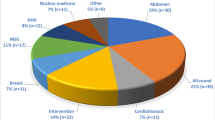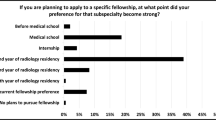Abstract
Purpose
The purpose of the study is to characterize current practice patterns of abdominal radiologists based on work descriptions within job postings on numerous national radiology specialty websites.
Methods
Job postings for either “abdominal” or “body” radiologists were searched weekly on five society websites (SAR, SCBT-MR, ARRS, ACR, RSNA) over a 1-year period. Postings were reviewed for various characteristics.
Results
Nine hundred and sixteen total ads for 341 unique abdominal radiologist positions were reviewed (34.6% academic, 64.2% private practice, 1.2% other). Postings occurred most commonly in March (12.3%) and least commonly in November (4.8%). States with most positions were Florida (27), California (26), and New York (24). Of postings delineating expectations of specific abdominal modalities, 67.4% mentioned MRI, 58.5% ultrasound, 41.1% fluoroscopy, 14.3% PET, and 54.0% interventions. Additional non-abdominal expectations included general radiology (28.7%), breast imaging (21.1%), and general nuclear medicine (9.7%). Additional skills included prostate MRI (7.0%), OBGYN ultrasound (5.0%), and CT colonoscopy (2.6%). 79.2% required an abdominal imaging fellowship (specifically a body MRI fellowship in 4.1%).
Conclusion
By using job postings for abdominal radiologists, we have taken a practical approach to characterizing the current status of this subspecialty, reflecting recent job expectations and requirements. The large majority of positions required a body fellowship, and the positions commonly entailed a variety of skills beyond non-invasive diagnostic abdominal imaging. Of note, expectations of considerable minorities of positions included abdominal interventions, general radiology, and breast imaging. These insights may guide the development of abdominal radiology fellowships and mini-fellowships, as well as assist radiologists entering or returning to the job market.

Similar content being viewed by others
References
Smith GG, Thrall JH, Pentecost MJ, et al. (2009) Subspecialization in radiology and radiation oncology. J Am Coll Radiol 6(3):147–159
Bluth EI, Bansal S (2016) The 2016 ACR Commission on Human Resources Workforce Survey. J Am Coll Radiol 13(10):1227–1232
Rosenkrantz AB, Wang W, Hughes DR, Duszak R (2017) Generalist versus subspecialist characteristics of the U.S. radiologist workforce. Radiology . https://doi.org/10.1148/radiol.2017171684
Prabhakar AM, Oklu R, Harvey HB, et al. (2014) The radiology job market: analysis of the ACR jobs board. J Am Coll Radiol 11(5):507–511
Society of Abdominal Radiology (2017) SAR Career Center. https://rad.abdom.associationcareernetwork.com. Accessed September 1, 2017
American College of Radiology (2017) ACR Career Center. https://jobs.acr.org/jobseeker/search/results/. Accessed September 1, 2017
Radiological Society of North America (2017) RSNA Career Connect. http://jobs.rsna.org/jobs. Accessed September 1, 2017
Society of Computed Tomography and Magnetic Resonance (2017) SBCTMR Career Center. https://careers.scbtmr.org/jobseeker/search/results/. Accessed September 1, 2017
American Roentgen Ray Society (2017) ARRS Career Center. http://careercenter.arrs.org/jobs/. Accessed September 1, 2017.
U.S. Census Bureau (2017) Census Regions and Divisions of the United States. https://www2.census.gov/geo/pdfs/maps-data/maps/reference/us_regdiv.pdf. Accessed November 6, 2017
Bluth EI, Bansal S, Bender CE (2017) The 2017 ACR commission on human resources workforce survey. J AM Coll Radiol 14(12):1613–1619
Accreditation Council for Graduate Medical Education (2017) ACGME Program Requirements for Graduate Medical Education in Abdominal Radiology. https://www.acgme.org/Portals/0/PFAssets/ProgramRequirements/421_abdominal_radiology_2017-07-01.pdf?ver=2017-04-27-140612-587. Accessed November 20, 2017
Society of Abdominal Radiology (2017) Society of Abdominal Radiology Bylaws. https://c.ymcdn.com/sites/www.abdominalradiology.org/resource/resmgr/About_SAR/2015.SAR_Society_Bylaws.pdf. Accessed November 20, 2017.
Author information
Authors and Affiliations
Corresponding author
Ethics declarations
Funding
None.
Conflicts of interest
Dr. Hoffman declares that he has no conflicts of interest. Dr. Rosenkrantz declares that he has no conflicts of interest.
Ethical approval
This study used publicly available data sources and did not include private identifiable information. As such, it did not constitute human subjects research. This article does not contain any studies with human participants or animals performed by any of the authors.
Rights and permissions
About this article
Cite this article
Hoffman, D.H., Rosenkrantz, A.B. Defining the abdominal radiologist based on the current U.S. job market. Abdom Radiol 43, 3184–3187 (2018). https://doi.org/10.1007/s00261-018-1577-1
Published:
Issue Date:
DOI: https://doi.org/10.1007/s00261-018-1577-1




